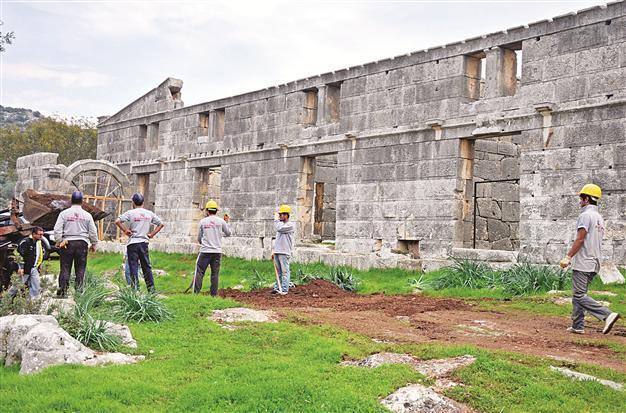Antalya to get new Lycia Museum
ANTALYA - Anatolia News Agency

In the museum, contemporary artists will be presenting their way of understanding, says the head of the excavations, says Professor Nevzat Çelik (R). The museum is expected to cost 8.6 million liras. AA photos
Antalya will soon see the opening of a museum focusing on the Lycian civilization, with excavation works continuing at the ancient sites of Myra and Andriake. The head of the excavations, Professor Nevzat Çelik, says the museum is planning to open within 15 months.
Çelik told Anatolia news agency that the excavation works being carried out were connected to the new museum, which is expected to cost 8.6 million Turkish Liras and is supported by the Turkish Culture and Tourism Ministry.
The museum will include features on Lycian culture, accessories, the life of St Nicholas, the early era of Christianity, second century ancient pier management, and how people at the time lived and survived. The museum will be organized within a thematic display.
In one area of the museum, reflections on Lycian artworks will be interpreted by modern day artists.
Glass and sculpture“We want this part to be more dynamic, so that’s why we are going to use glass and sculpture. In each part, contemporary artists will be presenting their way of understanding Lycia,” said Çevik.
“We have started out with ambitious aims. The Culture Ministry also supports us and it is our dream to accomplish and open this museum,” he added.
The museum will also include the biggest ancient wheat storage location in the Mediterranean, which is set to be unearthed as part of the excavations. “The storage excavation will tell us the trade story of the Mediterranean ports,” the professor said. “The storage and granaries date back to the 2nd century B.C. and will be our focus. It will be unearthed by the end of this year and will be arranged as a Lycian Museum.”
Myra was a leading city of the Lycian Union and surpassed Xanthos in early Byzantine times to become the capital city of Lycia. Its remains are situated about 1.5 kilometers north of today’s Demre, on the Kaş-Finike road. Most of the ancient city is now covered by Demre and alluvial silts, as it is located on the river Demre River in a fertile alluvial plain.
The date of Myra’s foundation is unknown. There is no literary mention of it before the first century B.C., when it was said to be one of the six leading cities of the Lycian Union (the other five were Xanthos, Tlos, Pinara, Patara and Olympos). It is believed to date back much further, as an outer defensive wall has been dated to the 5th century B.C.
The origin of Myra’s name is uncertain and may be a modified form of a Lycian name, such as Tlos and Patara. The name was popularly associated with the Greek name for myrrh, with the emperor Constantine Porphrogenitus describing the city as the “thrice blessed, myrrh-breathing city of the Lycians, where the mighty Nicolaus, servant of God, spouts forth myrrh in accordance with the city’s name.”
